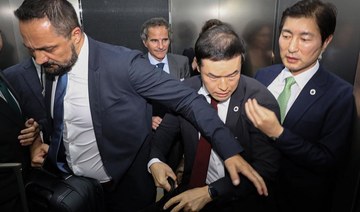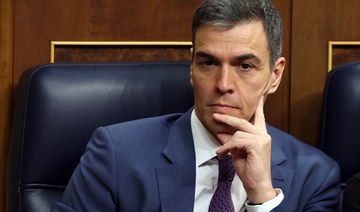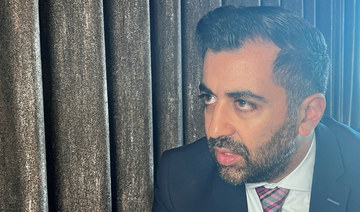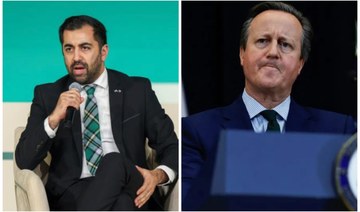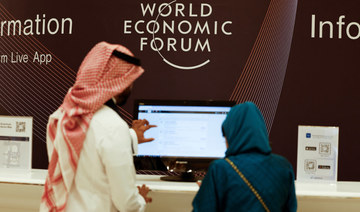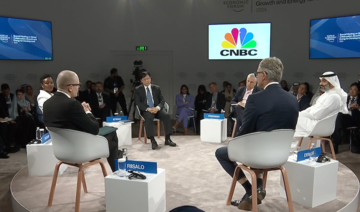SEOUL: South Korean opposition lawmakers sharply criticized the head of the United Nations’ nuclear watchdog for its approval of Japanese plans to release treated wastewater from the damaged Fukushima nuclear power plant during a tense meeting in Seoul on Sunday, with protesters screaming outside the door.
Rafael Mariano Grossi, the International Atomic Energy Agency’s director general, arrived in South Korea over the weekend to engage with government officials and critics and help reduce public concerns about food safety. The planned release of the Fukushima plant’s treated wastewater emerged as a major political issue in South Korea after the IAEA last week approved the Japanese discharge plans, saying the process would meet international safety standards and pose negligible environmental and health impacts.
South Korea’s government has also endorsed the safety of the Japanese plans, saying that the contamination levels of water pumped out from the plant would be within acceptable standards and wouldn’t meaningfully affect South Korean seas as long as the plant’s treatment systems work as designed.
In his meeting with visiting members of the liberal Democratic Party, which controls a majority in South Korea’s parliament, Grossi said the IAEA’s review of the Japanese plans was based on “transparent” and “scientific” research. He acknowledged concerns over how the Japanese plans would play out in actuality and said the IAEA would establish a permanent office in Fukushima to closely monitor how the discharge process is implemented over the next three decades.
The lawmakers responded by harshly criticizing IAEA’s review, which they say neglected long-term environmental and health impacts of the wastewater release and threatens to set a bad precedent that may encourage other countries to dispose nuclear waste into sea. They called for Japan to scrap the discharge plans and work with neighboring countries to find safer ways to handle the wastewater, including a possible pursuit of long-term storage on land.
The party has also criticized the government of South Korean President Yoon Suk Yeol for putting people’s health at risk while trying to improve relations with Japan.
“If you think (the treated wastewater) is safe, I wonder whether you would be willing to suggest the Japanese government use that water for drinking or for industrial and agricultural purposes, rather than dumping it in the sea,” Woo Won-shik, a Democratic Party lawmaker who attended the meeting, told Grossi. The party said Woo has been on a hunger strike for the past 14 days to protest the Japanese discharge plans.
Further details from the meeting weren’t immediately available after reporters were asked to leave following opening statements. Dozens of protesters shouted in a nearby hall while holding signs denouncing the IAEA and Japan, and they were closely watched by parliamentary security staff.
Hundreds of demonstrators had also marched in downtown Seoul on Saturday demanding that Japan scrap its discharge plans. Those protests provided a tense backdrop to a meeting between Grossi and South Korean Foreign Minister Park Jin, who called for IAEA’s “active cooperation” in reassuring the South Korean public.
The safety of Fukushima’s wastewater has been a sensitive issue for years between the US allies. South Korea and Japan have been working in recent months to repair relations long strained over wartime historical grievances to address shared concerns such as the North Korean nuclear threat and China’s assertive foreign policy.
South Korea’s assessment about the safety of the discharge plan was partially based on observations by a team of government scientists who were allowed to tour the Fukushima plant in May. Japanese Prime Minister Fumio Kishida had agreed to that visit during a May 7 summit with Yoon in Seoul, in a show of his desire for improved ties.
In a statement released by state media on Sunday, North Korea also criticized the Japanese discharge plans, warning against “fatal adverse impact on the human lives and security and ecological environment” resulting from the discharge of “nuclear-polluted water.” The statement, which was attributed to an unidentified official in North Korea’s Ministry of Land and Environment Protection, also criticized Washington and Seoul for backing the Japanese plans.
“What matters is the unreasonable behavior of IAEA actively patronizing and facilitating Japan’s projected discharge of nuclear-polluted water, which is unimaginable,” it said. “Worse still, the US and (South) Korea openly express unseemly ‘welcome’ to Japan’s discharge plan that deserves condemnation and rejection, provoking strong anger of the public.”
A massive earthquake and tsunami in 2011 destroyed the Fukushima plant’s cooling systems, causing three reactors to melt and release large amounts of radiation.
Tokyo Electric Power Company Holdings, which operates the facility, has been storing the treated water in hundreds of tanks that now cover most of the plant and are nearly full. Japanese officials say the tanks must be removed to make room to build facilities for the plant’s decommissioning and to minimize the risk of leaks in case of another major disaster. The tanks are expected to reach their capacity of 1.37 million tons in early 2024.
Japan first announced plans to discharge the treated water into the sea in 2018, saying the water will be further diluted by seawater before being released in a carefully controlled process that will take decades to complete.
South Korean lawmakers berate IAEA chief over Japanese plans to release Fukushima wastewater
https://arab.news/bbr6k
South Korean lawmakers berate IAEA chief over Japanese plans to release Fukushima wastewater
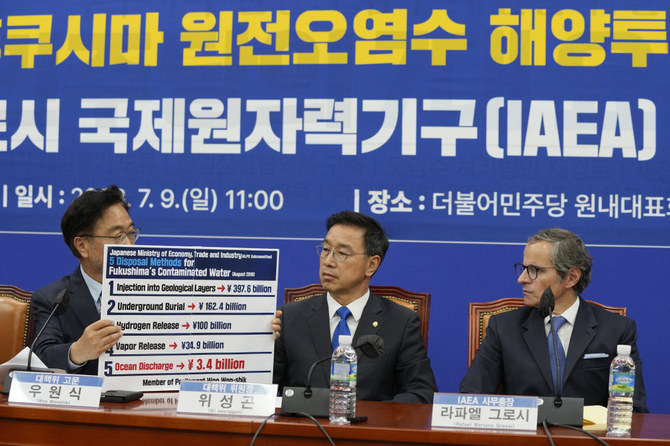
- Planned release of the Fukushima plant’s treated wastewater a major political issue in South Korea
- Japan called to work with neighboring countries to find safer ways to handle the wastewater
Iran slams crackdown on US student protesters

“The American government has practically ignored its human rights obligations and respect for the principles of democracy that they profess,” foreign ministry spokesman Nasser Kanani said.
Tehran “does not at all accept the violent police and military behavior aimed at the academic atmosphere and student demands,” he said.
American universities have been rocked by pro-Palestinian demonstrations, triggering campus clashes with police and the arrest of some 275 people over the weekend.
The demonstrations began at Columbia University in New York and have since spread across the country.
In Iran, hundreds of people demonstrated in Tehran and other cities on Sunday in solidarity with the US demonstrations.
Some carried banners proclaiming “Death to Israel” and “Gazans are truly oppressed,” state media reported.
The Gaza war broke out after the October 7 attack by Palestinian militants on Israel which killed 1,170 people, mostly civilians, according to Israeli figures.
Tehran backs Hamas, but has denied any direct involvement in the attack.
Israel’s retaliatory offensive against Hamas has since killed at least 34,488 people in Gaza, mostly women and children, according to the Hamas-run territory’s health ministry.
“What we have seen in American universities in recent days is an awakening of the world community and world public opinion toward the Palestinian issue,” Kanani said.
“It is not possible to silence the loud voices of protesters against this crime and genocide through police action and violent policies.”
Pedro Sanchez stays on as Spain’s prime minister after weighing exit
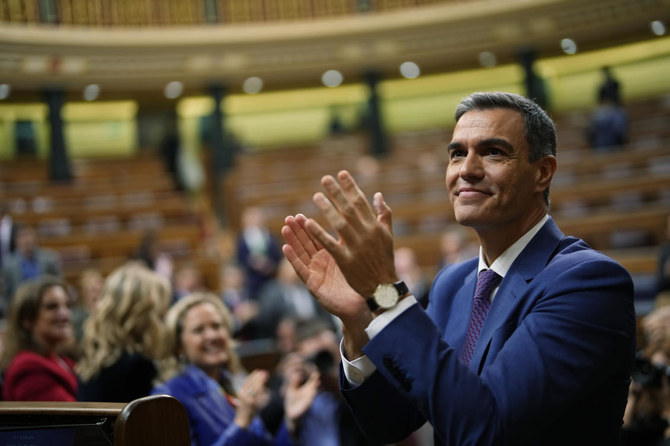
- Sanchez had surprised foes and allies when earlier said he considers quitting
- He described the court investigation of his wife Begona Gomez for influence peddling and business corruption as orchestrated by his opponents
MADRID: Spain’s Prime Minister Pedro Sanchez said on Monday he had decided to continue in office, days after abruptly announcing he was considering his future following the launch of a corruption investigation against his wife.
The center-left prime minister, 52, had surprised foes and allies alike when he said on Wednesday he was taking time from public duty to consider quitting. He described the court investigation of his wife Begona Gomez for influence peddling and business corruption as orchestrated by his opponents.
Sanchez met King Felipe VI on Monday — a step that would have been necessary should he have decided to resign — but announced in a televised address that he had informed the monarch of his decision to stay on. He had been encouraged to stay by widespread expressions of support over the weekend, Sanchez said.
“I have decided to go on, if possible even stronger as prime minister. This is not business as usual, things are going to be different,” he said in a national broadcast.
His announcement that he might quit had caused further turmoil in Spanish politics, where a fractious parliament has struggled to form coalition governments after close elections. Should a new election have been required, it would have been the fourth in five years.
The opposition will try to exploit the sign of indecision from Sanchez, but the impact may be limited because Spain’s political landscape is already so polarized, said Ignacio Jurado, political science professor at Madrid’s Carlos III University.
“His credibility is already hotly contested and voters have already given it to him or taken it away,” he said. “As a leader he has shown a weakness and it’s something that the opposition will exploit a lot.”
Scotland’s Yousaf will resign as first minister, BBC says
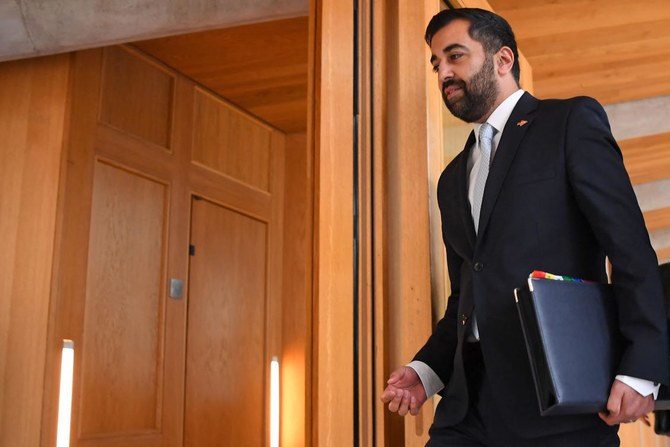
LONDON: Scotland’s first minister Humza Yousaf will resign as early as Monday, the BBC reported, after the possibility of him winning a vote of confidence this week appeared to dwindle over the weekend.
“Scotland’s First Minister Humza Yousaf (is) to resign as early as today, the BBC understands,” BBC News said, without citing a source.
Last week, Yousaf abruptly ended a power-sharing agreement between his Scottish National Party (SNP) and the Green Party, in the hopes that he could lead a minority government — but opposition parties have tabled a vote of no confidence.
The pro-independence SNP’s fortunes have faltered amid a funding scandal and the resignation of a party leader last year, while there has been infighting over how progressive its pitch should be as it seeks to woo back voters.
Just days ago, Yousaf said he was “quite confident” that he could win the no confidence vote called by political opponents, but by Monday, his offer of talks with other parties to try to shore up his minority government seemed to be faltering.
The leadership crisis and a second no-confidence vote against the Scottish government deepens problems faced by Yousaf’s Scottish National Party, which is losing popular support after 17 years of heading the Scottish Government.
Earlier this month, polling firm YouGov said the Labour Party had overtaken the SNP in voting intentions for a Westminster election, for the first time in a decade.
The leader of the Scottish Greens, Patrick Harvie, told BBC radio there was nothing Yousaf could say to persuade his party to support the first minister in the parliamentary confidence vote, leaving Yousaf with few options.
The vote is due to take place later this week.
A victory for Labour in Scotland in Britain’s next national election — expected later this year — would significantly bolster the party’s chances of taking power from Prime Minister Rishi Sunak’s Conservative Party.
If Yousaf loses, parliament would have 28 days to choose a new first minister before an election is forced.
Former SNP leader John Swinney has been approached by senior party figures to become an interim first minister in the event of Yousaf being forced from office, the Times newspaper said, adding that Swinney was reluctant to step up because of personal circumstances.
Yousaf, who previously held health and justice ministerial briefs in the Scottish Government, succeeded former SNP leader Nicola Sturgeon as first minister in March 2023.
She resigned last year and has since been embroiled in a party funding scandal with her husband, who was charged this month with embezzling funds. Both deny wrongdoing.
Global teacher shortage needs more than AI: WEF panelists
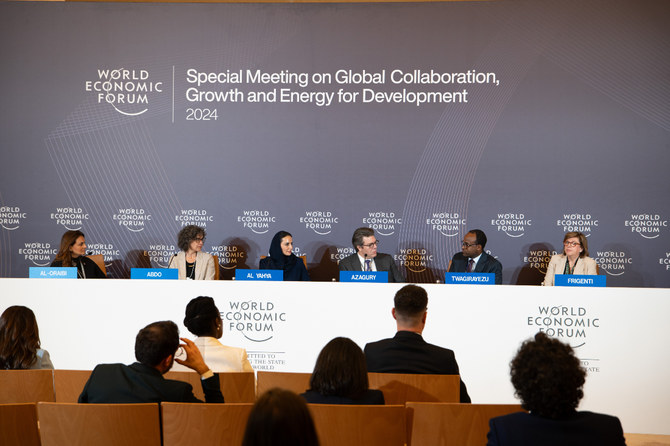
- Tailored solutions required for less-developed nations, says expert
- AI must complement education and training, changing of curricula
RIYADH: The global shortage of teachers will not be remedied solely through the use of artificial intelligence, according to education experts and decision-makers at the World Economic Forum’s Special Meeting in Riyadh.
“Teachers is the biggest problem at the moment for the education sector in low- and middle-income countries,” Laura Frigenti, chief of the Global Partnership for Education platform, told the panel on Sunday.
Gaspard Twagirayezu, Rwanda’s education minister, said that AI can revolutionize education and provide solutions for the global shortage of teachers.
“Of course, AI and technology are not going to replace teachers,” he added. “We can make sure that teachers are properly educated.”
“Here, we are trying to talk about how AI can help in producing education materials for the teachers so that we do not have all these expensive training sessions that we all have to go through.”
Stressing that AI can support teachers in the classroom, Twagirayezu explained that “teachers can be enabled to learn on their own using AI.”
Frigenti said that when it comes to harnessing the power of artificial intelligence in education, “there is not a kind of a one-size-fits-all technology that you can just import into one particular country.”
“You have to start from the conditions of that country and think in terms of a solution,” she continued. If there are no tailored solutions, this would “create a much bigger gap between a part of the world that can invest $8,000 per child per year in education and a part of the world that barely manages to invest $80.”
She added: “And that is going to create all sorts of socio-economic disparities, inequalities within society, (and) inequalities between the Global North and Global South.”
Frigenti added: “We integrate the improvements that technology and AI can add to the way in which the sector performs or is managed to a bigger way of thinking about the sector’s needs to transform, which includes a lot — changing the curricula (and) thinking about what you have to do for the (teachers) problem.”
The panel discussion, titled “Is Education Ready for AI,” featured speakers including Rudayna Abdo, founder and CEO of Thaki; Jack Azagury, group CEO of Accenture; and Deemah Al-Yahya, secretary-general of the Digital Cooperation Organization.
China’s robotic spacecraft headed for moon to carry payload from Pakistan
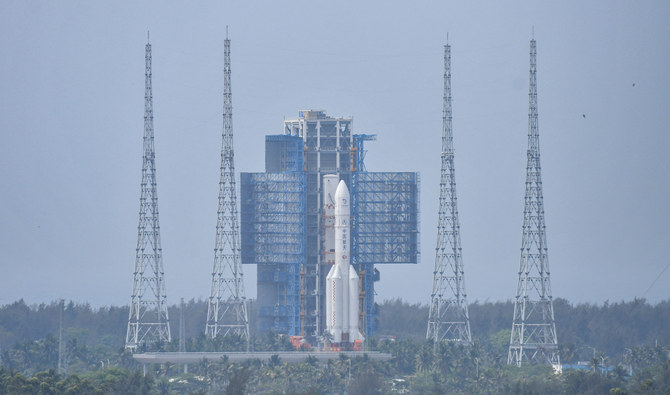
- China will send a robotic spacecraft in coming days on round trip to moon’s far side in first of three missions
- Chang’e-6 spacecraft will carry payloads from countries such as France, Italy, Sweden and Pakistan
BEIJING: China will send a robotic spacecraft in coming days on a round trip to the moon’s far side in the first of three technically demanding missions that will pave the way for an inaugural Chinese crewed landing and a base on the lunar south pole.
Since the first Chang’e mission in 2007, named after the mythical Chinese moon goddess, China has made leaps forward in its lunar exploration, narrowing the technological chasm with the United States and Russia.
In 2020, China brought back samples from the moon’s near side in the first sample retrieval in more than four decades, confirming for the first time it could safely return an uncrewed spacecraft to Earth from the lunar surface.
This week, China is expected to launch Chang’e-6 using the backup spacecraft from the 2020 mission, and collect soil and rocks from the side of the moon that permanently faces away from Earth.
With no direct line of sight with the Earth, Chang’e-6 must rely on a recently deployed relay satellite orbiting the moon during its 53-day mission, including a never-before attempted ascent from the moon’s “hidden” side on its return journey home.
The same relay satellite will support the uncrewed Chang’e-7 and 8 missions in 2026 and 2028, respectively, when China starts to explore the south pole for water and build a rudimentary outpost with Russia. China aims to put its astronauts on the moon by 2030.
Beijing’s polar plans have worried NASA, whose administrator, Bill Nelson, has repeatedly warned that China would claim any water resources as its own. Beijing says it remains committed to cooperation with all nations on building a “shared” future.
On Chang’e-6, China will carry payloads from France, Italy, Sweden and Pakistan, and on Chang’e-7, payloads from Russia, Switzerland and Thailand.
NASA is banned by US law from any collaboration, direct or indirect, with China.
Under the separate NASA-led Artemis program, US astronauts will land near the south pole in 2026, the first humans on the moon since 1972.
“International cooperation is key (to lunar exploration),” Clive Neal, professor of planetary geology at the University of Notre Dame, told Reuters. “It’s just that China and the US aren’t cooperating right now. I hope that will happen.”
SOUTH POLE AMBITIONS
Chang’e 6 will attempt to land on the northeastern side of the vast South Pole-Aitkin Basin, the oldest known impact crater in the solar system.
The southernmost landing ever was carried out in February by IM-1, a joint mission between NASA and the Texas-based private firm Intuitive Machines.
After touchdown at Malapert A, a site near the south pole that was believed to be relatively flat, the spacecraft tilted sharply to one side amid a host of technical problems, reflecting the high-risk nature of lunar landings.
The south pole has been described by scientists as the “golden belt” for lunar exploration.
Polar ice could sustain long-term research bases without relying on expensive resources transported from Earth. India’s Chandrayaan-1 launched in 2008 confirmed the existence of ice inside polar craters.
Chang’e-6’s sample return could also shed more light on the early evolution of the moon and the inner solar system.
The lack of volcanic activity on the moon’s far side means there are more craters not covered by ancient lava flows, preserving materials from the moon’s early formation.
So far, all lunar samples taken by the United States and the former Soviet Union in the 1970s and China in 2020 were from the moon’s near side, where volcanism had been far more active.
Chang’e-6, after a successful landing, will collect about 2 kilograms (4.4 pounds) of samples with a mechanical scoop and a drill.
“If successful, China’s Chang’e-6 mission would be a milestone-making event,” Leonard David, author of “Moon Rush: The New Space Race,” told Reuters. “The robotic reach to the Moon’s far side, and bringing specimens back to Earth, helps fill in the blanks about the still-murky origin of our Moon.”



